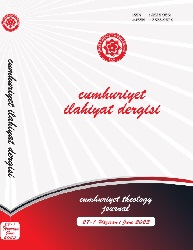Değişen Otoriteler: Sünnî ve Şiî Halkalarda Müşterek Nakledilen Bir Rivayetin İncelemesi
Changing Authorities: An Analysis of a Common Tradition Among Sunnī and Shi’ī Circles
Author(s): Ayşe Nur DumanSubject(s): History of Islam, Qur’anic studies
Published by: Cumhuriyet Üniversitesi İlahyat Fakültesi
Keywords: Hadith; Sunnī Hadith; Shi’ī Hadith; Common Narration; Hadith Transmission;
Summary/Abstract: Common narrations in Sunnī and Shī’ite literature are an important source that provide information about the early periods of hadīth history. Because, when the information in the ta’rīkh, tabakāt and rijāl books of Ahl alsunnah and Shī’a about the narrators in the isnāds of these hadīths is researched, the following conclusion is reached: The circle of a hadīth scholar in the 2nd/8nd century is open to the participation of narrators with both Sunnī and Shī’ite tendencies. The isnāds of common narrations also give information about when, where and through which transmitters they were transferred from one school of hadīth circle to another. However, the texts of the common narrations also carry traces of main debates between the Ahl al-sunnah and Shī’a. In addition, the texts of the common narrations give an idea about the debates and crises experienced in the formative period of Shī’a’s sectarian views. Therefore, it’s possible to obtain information about how these narrations changed during and after transmission between the Sunnī and Shī’ite circles, based on their texts. The hadīth, which is the subject of this article and whose text contains meaningful differences, “The essence of Islām is prayer, its branch zakāt and its peak is djihād in the way of Allah” is a common narration with these characteristics. Because this hadīth is narrated in Sunnī sources during a conversation between the Prophet Muhammad and Mu’ādh b. Djabal. But, in Shī’ite sources this hadīth is reported during a talk of Muhammad al- Bākir and Dja’far al-Sādik with his companions. In addition, there is another text of this hadīth in the Shī’ite literature that doesn’t come in the form of dialogue. But, in this hadīth Mu’ādh’s name isn’t explicitly mentioned and he is referred to as “a man”. The differences between the texts of Sunnī and Shī’ite narrations raise the following questions: Could it be that the Shī’ite narrators changed the speech of the Prophet with Mu’ādh as a dialogue between the imām and his companion? Just like the Prophet, did al-Bākir and al-Sādik have a similar conservation with their companions? What is the probability that the narration referred to as “a man” instead of Mu’ādh, due to the negative attitude of the Shī’a towards the Companions? Therefore, the aim of this article is to determine the transition process of this narration between Sunnī and Shī’ite circles and how meaningful changes in its text occurred. For this, information is given about the isnāds and texts of the hadīth in the Shī’ite and Sunnī literature, respectively. The narrators of the hadīth in Sunnī and Shī’ite isnāds have been researched from the ta’rīkh, tabakāt and rijāl works of two schools. Thus, it has been determined whether the narrators in the Shī’ite isnāds are related to the Ahl al-hadīth circles, whether the people in the Sunnī chains also adopt Shī’ite views and what their connections are with the narrators or hadīth circles of the Shī’a. As a result, it has been seen that this narration has gained fame in the hadīth circles in Kūfa since the beginning of the 2nd/8th century. It has been understood the narrators in the Shī’ite isnāds are not related to the Ahl al-Hadīth circles and that Suleymān b. Khālid and Abdullah b. Musqān in the Shī’ite isnāds played a role in the transmission of this hadīth as a conservation between the imām and his companions. On the other hand, the reason why Muādh’s name is left ambiguous as “a man” is that Shī’a position him as an anti-Ahl al-bayt Companion. It has also been determined that the narrators, who have intense contact with Shī’ite hadīth circles in the Sunnī isnāds, played a role in the transmission of this narration to the Shī’ite narrators.
Journal: Cumhuriyet İlahiyat Dergisi
- Issue Year: 27/2023
- Issue No: 1
- Page Range: 167-183
- Page Count: 17
- Language: Turkish

